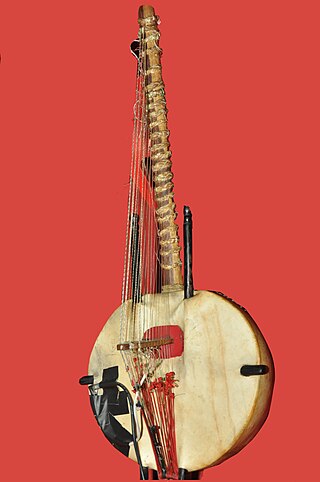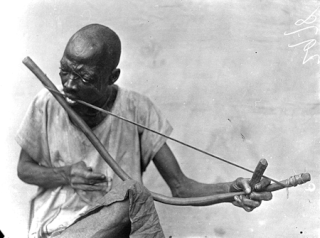
The kora is a stringed instrument used extensively in West Africa. A kora typically has 21 strings, which are played by plucking with the fingers. It has features of the lute and harp.

The musical bow is a simple string instrument used by a number of African peoples as well as Indigenous peoples of the Americas. It consists of a flexible, usually wooden, stick 1.5 to 10 feet long, and strung end to end with a taut cord, usually metal. It can be played with the hands or a wooden stick or branch. It is uncertain if the musical bow developed from the hunting bow, though the San or Bushmen people of the Kalahari Desert do convert their hunting bows to musical use.

The music of Burkina Faso includes the folk music of 60 different ethnic groups. The Mossi people, centrally located around the capital, Ouagadougou, account for 40% of the population while, to the south, Gurunsi, Gurma, Dagaaba and Lobi populations, speaking Gur languages closely related to the Mossi language, extend into the coastal states. In the north and east the Fulani of the Sahel preponderate, while in the south and west the Mande languages are common; Samo, Bissa, Bobo, Senufo and Marka. Burkinabé traditional music has continued to thrive and musical output remains quite diverse. Popular music is mostly in French: Burkina Faso has yet to produce a major pan-African success.

The music of Niger has developed from the musical traditions of a mix of ethnic groups; Hausa, the Zarma-Songhai, Tuareg, Fula, Kanuri, Toubou, Diffa Arabs and Gurma and the Boudouma from Lac Chad.

A griot is a West African historian, storyteller, praise singer, poet, and/or musician.

Xalam is a traditional lute from West Africa with 1 to 5 strings. The xalam is commonly played in Mali, Gambia, Senegal, Niger, Northern Nigeria, Northern Ghana, Burkina Faso, Mauritania, and Western Sahara. The xalam and its variants are known by various names in other languages, including bappe, diassare, hoddu (Pulaar), koliko (Gurunsi), kologo (Frafra), komsa, kontigi, gurmi, garaya (Hausa), koni, konting (Mandinka), molo (Songhay/Zarma), ndere, ngoni (Bambara), and tidinit.
The Hausa are one of the largest ethnic groups in Nigeria, Niger, Ghana, Sudan, Cameroon and in many other West and Central African countries. Their folk music has played an important part in the development of Nigerian music, contributing such elements as the Goje, a one-stringed fiddle. There are two broad categories of traditional Hausa music: rural folk music and urban court music. They introduced the African pop culture genre that is still popular today.

The music of West Africa has a significant history, and its varied sounds reflect the wide range of influences from the area's regions and historical periods.

The sintir, also known as the guembri (الكمبري), gimbri, hejhouj in Hausa language, is a three stringed skin-covered bass plucked lute used by the Gnawa people of Morocco. It is approximately the size of a guitar, with a body carved from a log and covered on the playing side with camel skin. The camel skin has the same acoustic function as the membrane on a banjo. The neck is a simple stick with one short and two long goat strings that produce a percussive sound similar to a pizzicato cello or double bass.

Ɗan Maraya Jos was a Nigerian Hausa griot known for playing the kontigi. He was also remembered as a man who did not limit his praise singing to the rich and famous, but sang praises for common people as well.

In many parts of sub-Saharan Africa, the use of music is not limited to entertainment: it serves a purpose to the local community and helps in the conduct of daily routines. Traditional African music supplies appropriate music and dance for work and for religious ceremonies of birth, naming, rites of passage, marriage and funerals. The beats and sounds of the drum are used in communication as well as in cultural expression.

The akonting is the folk lute of the Jola people, found in Senegal, Gambia, and Guinea-Bissau in West Africa. It is a string instrument with a skin-headed gourd body, two long melody strings, and one short drone string, akin to the short fifth "thumb string" on the five-string banjo.
Daniel Laemouahuma Jatta is a Jola scholar and musician from Mandinary, Gambia, who pioneered the research and documentation of the akonting, a Jola folk lute, as well as the related Manjago folk lute, the buchundu, in the mid-1980s. Prior to Jatta's work, these instruments were largely unknown outside the rural villages of the Senegambia region of West Africa.
Traditional Vietnamese musical instruments are the musical instruments used in the traditional and classical musics of Vietnam. They comprise a wide range of string, wind, and percussion instruments, used by both the Viet majority as well as the nation's ethnic minorities.

Hausa animism, Maguzanci or Bori is a pre-Islamic traditional religion of the Hausa people of West Africa that involves magic and spirit possession. While only a part of the Hausa people converted to Islam before the end of the 18th century, most of the adherents of the religion did the same between the jihad started by the Islamic reformer Usman dan Fodio around 1800 and the middle of the 20th century, while a small minority converted to Christianity. Religious affiliation to this traditional religion is virtually nonexistent at the beginning of the 21st century; however, Hausa animism and Islam among Hausa people have coexisted for centuries, and some practices related to animism carry on locally.

The garaya or komo is an oval-bodied, two-string spike lute from Niger and Northern Nigeria.

The gurmi is a two or three-stringed lute of the Hausa people of northern Nigeria. May also be called gurumi or kumbo. In looking at the two-finger playing style used by musicians who play the gumbri, researchers have listed it as a possible relative to the banjo. Researchers have talked about the gurmi and gurumi as if these are two different but similar instruments.

Molo is the name given to a lute by the Hausa people of Niger and northern Nigeria and the Songhay people of Niger. In Ghana, it is called Mɔɣlo in Dagbanli.

















